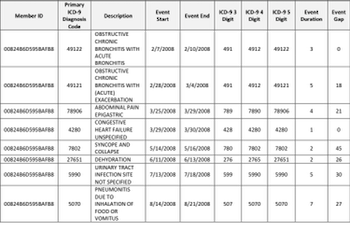Current Research Projects

Data-Driven Inelligent Transportation (DDTrans)
Transportation network (or road network) is a prime example of spatiotemporal networks, and ITS (Intelligent Transporation System) uses data-driven solutions to enhance the untilization of such networks. Given the multidimensional and evolving nature of these networks, enabling data-driven query and analysis operators on such networks is challenging. In the past, we have introduced a variety of novel operators for efficient querying and mining of transportation data in support of ITS. Currently, we are developing an alternative route-planning solution to optimize utilization of the transporation network by taking a "system optimal" approach as compared to the typical route planning approach that results in nash equillibrium at best. This project is sponsored by the Mountain Plains Consortium (MPC) and the Colorado Department of Transportation (CDOT).

Scalable Online Systems For System-Optimal Transportation Route Guidance
The state-of-the-art in transportation route guidance produces what may be referred to as User Equilibrium in Transportation Engineering, or more generally, a Nash Equilibrium in Game Theory. This is due to the fact that individual utility is maximized in the route guidance system, which makes this a non-collaborative game. With the emergence of ride share fleets as well as autonomous vehicles, we are poised with opportunities to reduce the overall system congestion, through agency collaboration, data-driven designs, and new control systems. We seek to identify System Optimal Route Guidance techniques, which attempt to coax the network flows into a state that maximizes system utility over individual utility.

Real-Time Disaster Detection through Social Media
This project is a continuous research on utilizing social media, specifically Twitter, in identifying a disaster when it unfolds. Some data sets have been collected for recent natural disasters including Hurricane Harvey, Irma and Maria in addition to past disasters such as Hurricane Matthew. Part of the work is on identifying the heuristics of static Twitter data during the disaster, extracting meaningful knowledge such as disaster type, location, and needed resources. The goal ultimately is to be able to detect any disaster whether natural or man-made in real-time as part of a complete Cloud-based system for disaster management and response.

Development and Evaluation of a Similarity Measure for Medical Event Sequences
Although the healthcare industry has large databases of medical histories, medical professionals underutilize this potential resource. Medical professionals lack tools to compare medical histories of patients and use medical histories to improve decision-making. Therefore, we initiated a research agenda to utilize medical histories in decision-making by healthcare providers. The fundamental part of his plan is a similarity measure to help medical providers better identify patients that have strong resemblance based on their medical history. Measures developed in previous studies do not use unique aspects of medical histories and were not evaluated on real medical history data. The results of our first study are published in the paper "Development and Evaluation of a Similarity Measure for Medical Event Sequences," ACM Transactions on Management Information Systems, August 2017. The initial study indicated the superiority of the similarity measure compared to previously developed measures. However, larger questions remain unanswered about using the similarity measure to improve decision-making by medical professionals.

Decision-Making Performance of Similarity Measures for Medical Event Sequences
A second related study involves evaluation of the similarity measure to improve data mining performance in medical applications. Specifically, we use the similarity measure developed for our first paper to predict mortality and high-risk patients. This study uses data from the National Trauma Data Bank for mortality prediction and the Center for Medicare and Medicaid for risk prediction. Papers concerning the mortality and risk prediction performance of medical event sequence similarity measures are scheduled for submission during 2018. The longer-term plans involve development of a query architecture for medical histories and evaluating usage of the architecture by medical professionals. A usage case for the query architecture could look something like the following. A doctor is presented with a complex case. Instead of relying on intuition or anecdotal evidence, the doctor utilizes the query architecture to search relevant medical histories. By providing data like demographics, circumstances, and symptoms of the patient, the query architecture then retrieves a list of similar cases that help the doctor see how other doctors have diagnosed and treated patients under similar circumstances. The doctor would then use these similar cases to make a more informed diagnosis and appropriate treatment for the patient
Perforated Microstructures for 4D Behavioral Control of Elastic Materials
The core of this research introduces data-driven procedural meshing that can be used in both Finite Element (FE) simulation of elastic materials and 4D behavioral printing to improve modeling-to-reality accuracy of simulated and printed deformable models. Research topics include: automated behavioral surface reconstruction of real-world objects, geometric mesh perforation for procedural modeling, and data-driven behavioral optimization for 4D printing.

Progressive Alignment for High Throughput Sequence Data
With the advent of Next Generation Sequencing (NGS) technologies, availability of genetic data is growing rapidly. New techniques are needed to manage, process, and analyze this data for both research and clinical applications. This research focuses on developing new index structures for delivering the most relevant information quickly and avoiding long waits for existing analysis pipelines to complete before being able to make critical decisions.

Real-Time Thermal Medium-Based Breathing Analysis
Respiratory monitoring is used in medical applications to detect abnormal breathing conditions. Methods of respiration monitoring either place sensors on the patient’s body and cause discomfort and alter natural breathing, or they measure respiration remotely at the cost of accuracy. We present a method of non-contact analysis that monitors respiration directly and remotely. We place a thin medium perpendicular to the individual’s face, and record the heat signature from their breath on the material using a thermal camera. We then use image processing to extract respiratory behaviors.